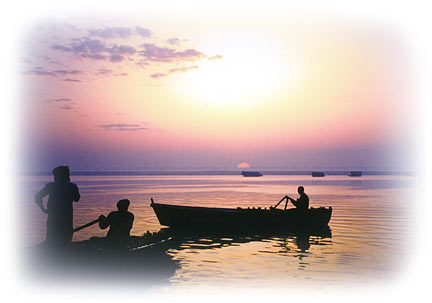

India Dreaming
Accounts of previous tours to India by Sundaram
Part Ten: Durga Puja
We left our hotel while it was still dark, proceeding via bicycle rikshaw through the pre-dawn streets of Varanasi. We passed sections illuminated all around with brightly colored lights announcing that we were arriving at another of the many temporary temples which had been erected throughout the city in celebration of Durga Puja, one of the major holy days in the Hindu calandar. Durga Devi, a symbol of the feminine Divine as both beauty & power, rides on a tiger or lion, resplendent with many arms & weapons, slaying the buffalo demon, Mahishasura with Her trishula (trident). Durga is "Tripurasundari," the most beautiful in all the three worlds; She is Mother Nature, & the fierce protectress of Her devotees.
Constructed on wooden frames with straw, the murtis (consecrated images) are molded out of Ganges clay by a colony of artisans that make them generation after generation. They can be as much as 7 feet tall with Her divine attendents such as Lord Ganesha, Kartikeya & others. They are beautifully adorned, much the same as if they were permanent deities in an established temple. For 3-days She is enthusiastically worshipped with many pujas & aratis. The devotees attending to each Durga murti become very attached to Her, for to them, She is non other than the living embodiment of
the Divine Mother, Herself.
After an hour or so we arrive at Dasaswamedh Ghat, the main bathing ghat of Varansai, although only one of approximately 78 ghats lining the riverfront. We make our way down the ancient stone steps to the river, lined by destitue beggars & lepers, to the water where many row boats are awaiting our arrival. A boat ride on the Ganga at dawn is an essential part of any pilgrimage to this ancient holy city. We watch the brahmins (priests) under their umbrellas, blessing pilgrims, then purchase our small leaf-boats filled with marigold flowers & a cube of camphor from the young girls who make their rounds, hopping from boat to boat. Soon we are off, reciting our mantras, especially the Gayatri mantra, or Om Namah Shivaya, as we say our own individual prayers & send our fire-filled leaf boats
into the morning current. Tradition has it that if the flame on your leaf-boat is still
burning when it disappears from sight, your prayer will be answered or your wish
come true. May it be so!
We see the platform at Dasaswamedh Ghat where Mataji was living underground when, as told in Autobiography of a Yogi, she called Babaji, Lahiri Mahasaya & Ram Gopal Muzumdar there to witness Babajis immortal promise to retain his physical body throughout this present world cycle. We see the steps leading to the lane of Lahiri Mahasaya's home, where we will go the next day. We see Manikarnika Ghat, the ancient burning ghat, as well as Harischandra Ghat, the modern crematorium. We pass Hanuman Ghat & Tulsi Ghat, where Sant Tulsidas lived & where he wrote Ramcharitamanas, the Hindi re-telling of the epic Ramayana, which Mahatma Ghandi called "the greatest work of devotional literature ever written." It is told thatLord Hanuman, himself, narrated that book to Tulsidas. We have brought a small harmonium & are chanting in our boat. The atmosphere is very peaceful & filled with a perceptible divine vibration. The sun has risen. We moor our boat & prepare for a bath in the holiest of holy rivers at the most holy of holy places: Varanasi.
The water is warm & the feeling indescribable. For how many thousands of years have pilgrims bathed here? We face the rising sun, pour water from our hands back in to the river as an offering, say our mantras & prayers, then dunk three times. We don't want to leave the water, but float, swim or just stand there up to our necks in contentment. Artha Dhyanam: "Now, meditation!"
Part 11: Durga Puja, Continued



